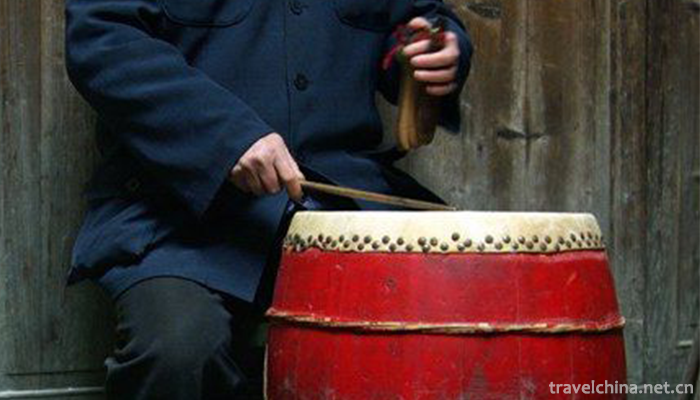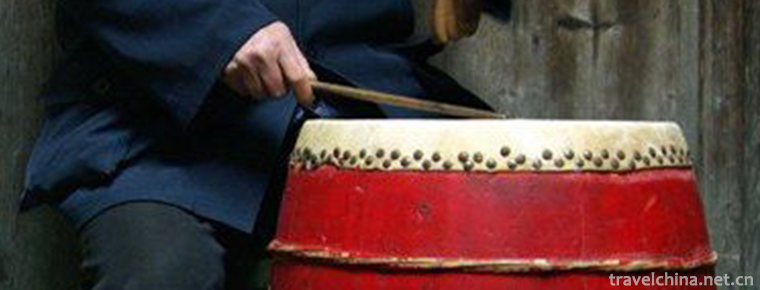Lishui drum words
Lishui drum words
Lishui Drum Ci is a popular rap art in Liandu and its surrounding areas in Lishui City, Zhejiang Province. Lishui Drum Ci originated from the Tang Dynasty. During the reign of Emperor Li Shimin, it was popular in the 1950s and 1970s. In order to enrich the cultural life of the masses and publicize the Party's policies and policies, it was usually sung in rural areas during the leisure season. Lishui Drum Ci is a slab cavity, often used in narrative or endorsement with a steady rhythm of four or two beats. The accompanying instruments are "tanggu" and "cut".
On November 11, 2014, Lishui Drum Ci was approved by the State Council and listed in the fourth batch of national intangible cultural heritage list.
Historical origin
Lishui Drum Ci was sung in Lishui dialect, which had no proven origin, but it was very popular in Jiadao period of Qing Dynasty at the latest. According to the 26-year edition of Lishui County Chronicle by Qing Daoguang, Tu Benren (who served in Lishui County from 1805 to 1826) was an orator of Lishui County. He tasted with such customs and events as Lei Xuehai's poetry singing and Shangyuan Lantern Club and Madame Shunyi (Mrs. Chen XIV) worshiping in the ancestral hall of Quanzhou. Among them, such words as "singing poetry and paying for Qu Meng, harmony between God and Spring", "smoke lanterns in the ancestral of Boli Temple, and Bazan singing Blind Zhigong". In the third year of Tongzhi's reign in Qing Dynasty, Yunhe County Chronicle, Custom Chapter, there is an article "Yingshen Trivial Records" written by Liu Xiangfeng, a famous scholar in the county. Among them, Yun: "There are people singing"Madame's Ci"in the western town of Liyi, who narrate different things and are well known by the common customs." It can be seen that the drumming and singing activities with "Madame Singing" as the main content were very common in Lishui city and countryside at that time. By the 22nd year of Guangxu, Lishui Drum Ci artists had their own guild organization, "Drum Ci Xing" (known as "Madam Xing"). When the folk sought happiness, welcomed auspicious, dispelled diseases and evils, singing "Madam Ci" had become a fashion. In the fifteenth year of the Republic of China, Lishui Drum Ci Industry will reorganize and revise its rules and regulations, stipulating that artists must meet at "Madame Temple" on the seventh day of July every year. At that time, Lishui Drum Ci was not only very active in the territory, but also spread to adjacent Yunhe County and Zhangcun area of Qingtian County.
In the early period of liberation, there were more than 70 drum CI artists in Lishui County. The Cultural Department organized many times to study and train them. They successively created many songs, such as "Three Ages Enemy", "Little Two Black Marriage", "White-haired Girl", "Eye Digger Xu Gujin", "Suppression of Counter-Revolution", "Moon Red", "Huang Jiguang" and "Selling the Surplus Grain", which were propaganda and singing in coordination with previous political movements. During the Cultural Revolution, traditional drums were banned, and artists changed careers or lost their jobs. Since the 1980s, a small number of artists have returned to their old careers to make a living singing "Madame's Ci". The more famous and still alive artists are Zhang Shuijin of Lishui. He has a rich repertoire and a sweet voice. He is good at singing "Chasing Han Xin", "Nine Dragon Whip", "Silver Cup Record" and so on. His narrative is clear and easy to understand. When speaking, he sings like a man and an elephant woman. Everywhere you go, you are welcome.
Classic tracks
There are many traditional repertoires of Lishui Drum Ci. In addition to Madame Chen XIV, Guan Shiyin, Luoyang Bridge and Jiulong Whip, which are commonly used by Lishui, Yunhe and Zhangcun, there are also long-standing repertoires with regional features in Lishui, Yunhe and Zhangcun. For example, Lishui has nearly 20 copies such as "Sun Pavilion", "Silver Cup Record", "Poetry Fan House". Yunhe has more than 10 copies such as "Shuanglong Club", "Double Lions Tu", "Woman's Queen". Zhangcun has more than 10 copies such as "Flying Dragon Sword", "Pearl Tower" and "Qingmei Ji". The longest "Mrs. Chen 14" can sing for seven days and seven nights. In addition, there are many short songs which do not have the plot, such as "Bet and sigh", "Mother-in-law's advice", "Brother's advice", "Prodigal son's return". In 1956, Yun and Xu Dengming's new drum Lyric "Blindness and Heart Red" won an award in Lishui and participated in the provincial art festival the following year.
representative figure
Zhang Yongjin artists have been to Suichang, Songyang, Jingning, Yunhe, Jinhua, Qingtian, Wenzhou, Longquan and other places to sing.
His performances include: Mong Lijun, Chop Han Xin, Pearl Tower, Tianbao Tu, Peony Pavilion, Bu Du Ji, Bet and Sigh.
Local repertoire: Bihu Scenery, Jiulong Whip, Bu Du Ji, Bag Ji, Huapai Ji, Yinyang Jiao, Blood Diary Ji, Bet and sigh, Qingmei Ji, Peony Pavilion, Flower Selling Ji, Dragon Boat Sigh and so on; Little story "Fourteen Ladies", "Tianbao En", "Pearl Tower", "Meng Lijun", "Chop Hanxin" and more than 100 others. One.
artistic characteristics
The basic melody of Lishui Drum Ci, commonly known as "Lishui Drum Ci Tune", consists of two sentences, the upper and lower, mainly in the palace mode, the upper sentence or "Shang", or "feather" or "corner", and the next sentence is "palace", which is quite stable. Most of the melodies are composed of seven words.
Lishui Drum Ci is a slab cavity, often used for narration or endorsement with a steady rhythm of 42 beats. When angry, there is a slap board and scolding board with a beat appearing, with more words and less words. Lishui drum lyrics are mostly singing in single-stage, and the singers are blind. The accompanying instruments are "tanggu" and "cut". "Cut" is made of five pieces of pear wood or bamboo connected by ropes. When singing, take the sitting position, hold the "cut" batter in the left hand (strong beat), and beat the drum with a stick in the right hand. Before singing the original drum lyrics, it is often after the drum is quiet to sing a "soup head" (mostly a short passage of blessings, auspiciousness, warning, etc.) to attract the audience.
From the singing style, there are:
1. Sanjiang Rhyme: From the weir head - Shiniu is called Sanjiang Rhyme, that is, where the Bihu dialect is called Sanjiang Rhyme.
2. Qiyang Rhyme: After dressing up, sing.
3. Tian Jiangyun: Singing in Lishui dialect.
4. A clear word: no tone, clear pronunciation, singing in Lishui City. In addition, the singing style also has sad tune, happy tune and so on.
General accompaniment music: big drum, two drum boards, small gong, big gong, chaibu, etc. Places for performances: ancestral halls, alleys, pavilions, stage, farmer's home halls and so on.
Living condition
With the diversification of people's cultural activities, the situation of drum singing and lyrics is declining day by day, the number of practitioners is decreasing, while the old artists are gradually passing away, and they are facing the loss of biography. Only a few people like drum lyrics, occasionally performing in some festivals or in remote mountainous countryside. Artists can hardly survive by singing drum lyrics alone. Many have changed their professions. Some artists mainly sing "Madame 14" and "Singing Guanyin". At present, they are in an endangered situation in which artists and listeners are followed by few people.
Inheritance significance
Lishui Drum Ci, with its unique regional cultural flavor, flexible and convenient performance, regardless of place, has become a pearl in Lishui local folk art. Tracing back to the contents of drum ci, we are glad to find that in a long historical period, it not only carries the aesthetic wisdom of the people of Chuzhou, but also serves the people's spiritual ideas. In the past, the performance of drum lyrics was mostly related to local folk activities, daily entertainment, red and white happy events and praying for God. Drum lyricists were invited to perform. The activities of rap and singing performance "Madam Ci" which have been circulated to this day have a very strong sense of entertainment and prayer, reflecting people's unique ideology and ideological pursuit and unique value.


-
1.Red Cooked Chicken Daokou Style
Red-Cooked Chicken, Daokou Style is one of the traditional specialties. It is made by Yixing Zhang family roast chicken shop in Daokou Town, Huaxian County, Henan Province
Time 2018-11-26 -
2.Wudang Mountains Scenic Area
Wudang Mountain, the holy place of Taoism in China, is also known as Taihe Mountain, Xieluo Mountain, Shenshan Mountain and Xianshi Mountain. It has been called "Taiyue", "Xuanyue"
Time 2018-12-12 -
3.Ancient Town of Yi Nationality
The ancient town of Yi people is located in the north of Yongan Avenue, the west of Sun Li Park, the east of Longchuan River and the south of Chuda Expressway in Chuxiong Economic and Technological De
Time 2019-03-04 -
4.Silver Cave
Yinzi karst cave is a typical karst landform, which runs through 12 peaks and belongs to floor-type karst cave. The cave contains stalactites developed in different geological ages
Time 2019-03-04 -
5.Folk Stories of Ancient Fishing Goose
Ancient fishing geese folklore is a local folklore story based on fishery culture, which originated and spread in the Erjiegou area of Liaohe Estuary, Dawa County, Panjin City, Liaoning Province.
Time 2019-05-01 -
6.Hakka Folk Songs in Meizhou
Meizhou Hakka folk song is a Hakka folk song sung in Meizhou City, Guangdong Province (Meijiang District, Meixian District, Xingning City, Wuhua County, Fengshun County, Dapu County, Pingyuan County,
Time 2019-06-03 -
7.Qianjiang Folk Songs
Qianjiang folk song is a traditional folk song in Hubei Province. Popular in Qianjiang City, folk songs created by local working people in their work, life and customs. Its rich content,
Time 2019-06-10 -
8.Legend of Wang Zhaojun
Wang Zhaojun's legend is one of the local folklores in Xingshan County, Hubei Province. Wang Zhaojun, one of the four beautiful women in ancient China, is the embodiment of beauty, the messenger of pe
Time 2019-06-26 -
9.Awakening Drama
Yongkang Xinggan Opera, also known as "Jianggan Opera", is a traditional opera that serves religion. Mainly to persuade people to reflect, guide people to rectify, mainly in sacrificial occa
Time 2019-07-08 -
10.Zhangjiajie Yangxi Opera
Zhangjiajie Yangxi Opera originated in the middle of Qing Dynasty and has a history of more than 300 years. It belongs to Beilu Yangxi Opera. The singing feature is the singing method of "golden
Time 2019-07-16 -
11.Bowang mountain
Bo (B ó) Wang mountain, also known as Bowang mountain. Bowang mountain is one of the most important breeding and living places of the ancient Bo nationality. It was known as lunzhudadun and shitoudazhai in ancient times
Time 2020-10-16 -
12.Population of Yibin
By the end of 2019, the total registered residence of Yibin was 5 million 515 thousand, 8 thousand less than the end of last year, and the registered residence population urbanization rate was 37.87%, which was 2.28 percentage points higher than that
Time 2020-12-18